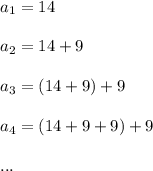
Mathematics, 02.08.2019 05:50 Nathaliasmiles
Find the indicated term of each arithmetic sequence a(1)=14, d=9, n=11

Answers: 1


Another question on Mathematics

Mathematics, 21.06.2019 16:10
To find the extreme values of a function f(x.y) on a curve x-x(t), y y(t), treat f as a function of the single variable t and use the chain rule to find where df/dt is zero. in any other single-variable case, the extreme values of f are then found among the values at the critical points (points where df/dt is zero or fails to exist), and endpoints of the parameter domain. find the absolute maximum and minimum values of the following function on the given curves. use the parametric equations x=2cos t, y 2 sin t functions: curves: i) the semicircle x4,y20 i) the quarter circle x2+y-4, x20, y20 b, g(x,y)=xy
Answers: 2

Mathematics, 21.06.2019 19:40
The krasnapolski is a top-of-the-line hotel in amsterdam, the netherlands. among their many services, they rent bicycles to guests. the bicycle checkout is open 24 hours per day 7 days per week and has 50 bicycles on hand. on average, 10 guests request a bicycle each day, arriving completely randomly at all times of the day during the spring and summer seasons. guests keep bicycles for four days on average, with a standard deviation of two days. how long does a guest on average have to wait for a bike? a. approximately 24 hours b. approximately 0.033 hours c. approximately 4 days d. approximately 47 minutes
Answers: 3

Mathematics, 21.06.2019 21:30
Ijust need these 2 questions answered (the second pic is just confirmation i'm not confident in that answer)
Answers: 1

Mathematics, 21.06.2019 23:00
Rob filled 5 fewer plastic boxes with football cards than basketball cards. he filled 11 boxes with basketball cards.
Answers: 1
You know the right answer?
Find the indicated term of each arithmetic sequence a(1)=14, d=9, n=11...
Questions



History, 04.05.2021 21:30






World Languages, 04.05.2021 21:30




Geography, 04.05.2021 21:30


Chemistry, 04.05.2021 21:30

Mathematics, 04.05.2021 21:30

Mathematics, 04.05.2021 21:30

Arts, 04.05.2021 21:30


History, 04.05.2021 21:30

 . Also, we are given that the common difference is 9, which means that each next term is obtained by adding 9, as follows:
. Also, we are given that the common difference is 9, which means that each next term is obtained by adding 9, as follows: .
. , we must add (n-1) nines to 14.
, we must add (n-1) nines to 14. 


